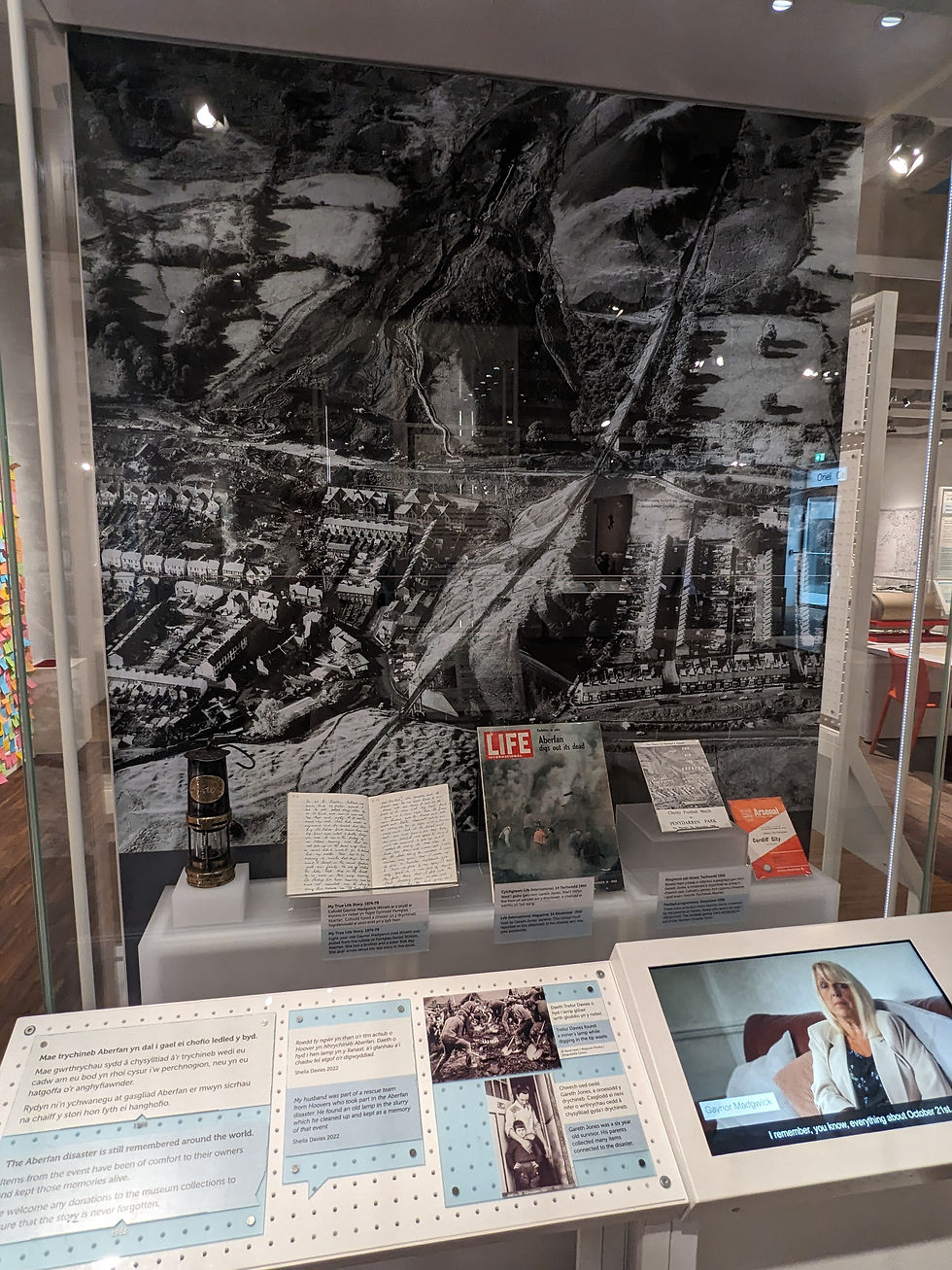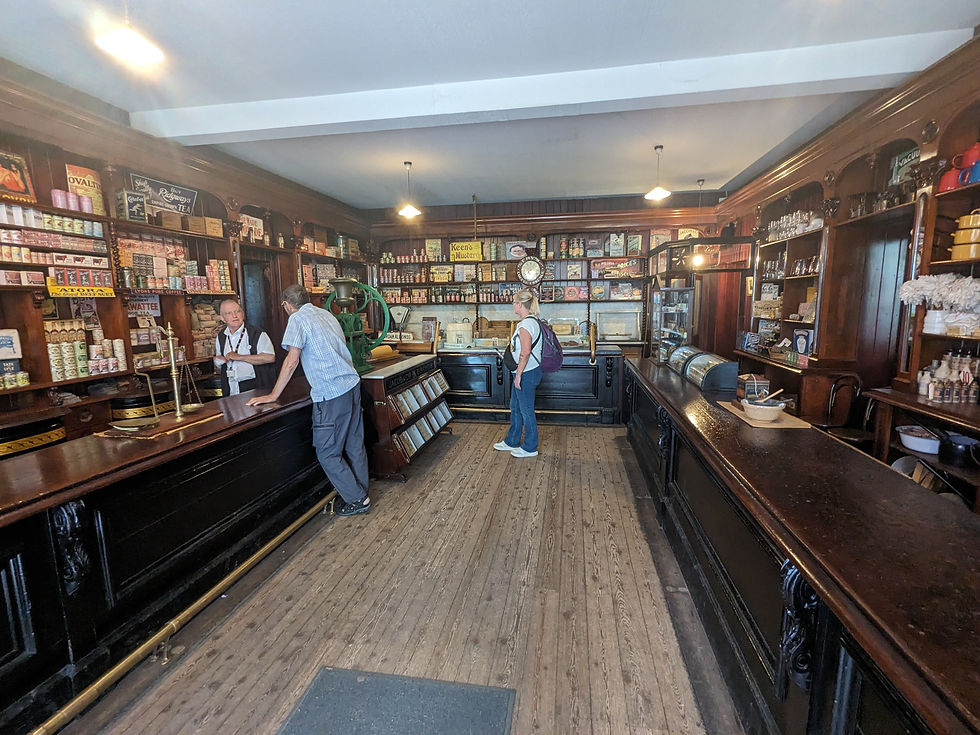18 June - Sain Ffagan Amgueddfa Werin Cymru
- chirp54
- Jun 20, 2024
- 6 min read
Sorry, I couldn't resist. That's Welsh for Saint Fagan's National Museum of History, and it was our destination today. We had originally planned to go the the Cardiff Museum, but Taylor Swift was doing a concert at the Principality Stadium which is right by the bus station and we figured Cardiff would be all but impassible. We took the bus toward Cardiff, then got off and walked about 30 minutes to the museum. It was an incredibly frightening walk, not because the surroundings were dodgy, but because the road was quite narrow and lacked sidewalks. Now, this wouldn't be such an issue if it were a sleepy little village road, but this road had lots of fast-moving traffic.
Every time there was bend in the road we had to cross to the other side so drivers coming around a blind curve wouldn't send us flying. It was a pretty tense thirty minutes but we finally got there.
This is the most unusual museum, and vast. The galleries look at aspects of Welsh life and Welsh history, from the Romans through today. The Roman are quite well represented. This was my favorite bit: a Roman period cup made in Italy but found in Abergavenny Wales. The leopard was a symbol of Bacchus.
Wales' history is incredibly rich and there are so many digs that have been done here that uncover evidence of ancient civilizations. One fascinating display was of a skull of a Neolithic man. Scientists and archeologists were able to recreate what he would have looked like. Various stages of reconstruction are shown above the model of the man's head.
They reckon that he lived 5,700 years ago and that his people raised sheep.
This Middle Bronze Age bowl (1300-1150 BCE) was discovered during drain digging by the River Alun in northern Wales. The x-ray on the right reveals where gold foil and tin insets survive.
There was a wonderful theme in one of the galleries: Wales is... It highlighted things that are quintessentially Welsh.
The Caradog's Cup, awarded at the National Brass Bands Festival:
This is thought to be the face of Llywelyn Fawr:
There was a display of typical Welsh clothes, and a dress-up box!
There were some pieces that didn't seem to follow a theme, but were just cool. This is the bed of Sir Rhys ap Thomas who fought beside Henry Tudor in his war against Richard III. In his day, beds were for showing off as well as sleeping. Visitors to his home could see his bed, which is why it's so ornate.
There were children's toys,
and sheet music written by or recorded by Welsh musicians.
There were a lot of references to coal mining,
and mining disasters.
The worst part of that story was the fact that the manager paid a £24 fine and the company paid a £10 fine. In the Aberfan disaster a spoil tip (a pile of waste from the mine) collapsed on the village of Aberfan. One hundred seven thousand cubic meters of black slurry cascaded down the hill like an avalanche. All the houses on the hill, eighteen houses in the village, the primary school and part of the secondary school were destroyed. 144 people were killed, 116 of them children between seven and ten who died in their classrooms. The display included a very moving film of people who were children in the schools at the time recalling the event.
There was a wall where visitors could write their feelings about the event.
There was a display about Welsh farming and sheep raising
displays of Welsh pottery, a recreation of a typical 1940s kitchen, and an entire room devoted to the Welsh women who protested against nuclear weapons after WWII. And that's all just in the galleries. The place is also a bit of a living museum like Old Sturbridge Village in Massachusetts or Colonial Williamsburg. We left the building and found some wonderful new friends. One of them was a particularly good singer,
There were houses that had been in disrepair but that were rebuilt.
You see the little loft-like area in the right photo? That's where the children would sleep. If a girl never found a husband and continued to sleep there in her parents' house, she was said to be "left on the shelf."
There were lots of reconstructed buildings: a post office, a toll house, a school and lots of farm buildings. Several buildings are still in operation, like the bakery and its little shop next door where you can buy a limited assortment of breads. They have craftspeople onsite demonstrating their crafts, on a rotating basis. There's a clogmaker, weaver, miller and blacksmith on site. Of course, not all of them are there all the time, and not all the houses are open all the time, due to a lack of volunteers.
There's a general store which was set up as it was in the 1920s.
The guy in the blue shirt was asking the shopkeeper about a particular brand of canned berries on the shelf. He said he used to work as a picker for the company.
This row of houses were staged as if from different eras, so you could see how, over the years, the standard of living had changed.
And, of course, there's a pub. A working pub! And, yes Bruce had a beer.
St. Teilo appears again, this time at St. Fagan's. This is the St Teilo church.
Llys Llywelyn's court is a grand building, and the volunteer there shared great stories. She told us that in addition to being a successful warrior, Llywelyn was a talented politician. He even married the daughter of the English king. That helped ensure that the English wouldn't attack Wales - at least not as often.
The throne
We then made the long walk back in time to the Iron Age Roundhouses.
All this walking made us hungry, so we stopped for a quick lunch before heading to the other side of the property and St. Fagan's Castle. The approach is spectacular.
There are lovely gardens, most of which were just starting to bloom.
I can just picture my carriage approaching the house and rounding the circle.
The house could use a lick of paint.
A medieval castle dating from the 13th century previously existed on the site; construction on the current house was started in 1586. A new owner, Sir Edward Lewis, bought the house in 1616 and the interior dates partly from then and partly from after 1850, when Lady Harriet Clive carried out decades of restorations. As you enter the house, you see a huge crest in the entryway.
I asked the volunteer on duty why there was an elephant on the crest. She told me that one of the house's owners was Viceroy of India.
Though it doesn't look it, thanks to the "smart filter" on my camera, the house is very dark.
Only a few rooms on the ground floor are open to the public, but they're quite grand.
There was, of course, the servants' areas on display
There was an interesting sign which listed all the duties of the staff on a typical day. Their day started at 6:00am and ended at midnight.
We walked out of the house and into the gardens, through hedge-lined passages and into the rose garden,
past the herb garden
down a lane
to the woolen mill.
Normally the combing machine would be working
but the teeth on the roller combs were so clogged with wool that the miller had to clean the rollers by combing out the wool by hand. He had finished most of the ones you see on the floor, but still had four or five to go, so we didn't get to see the mill in action. On the right of the photo you can see the spooling machine. In a small room on the other side of the mill, were the looms.
I loved this old poster on the mill wall.
We started the walk back to the exit and passed this wonderful old building where crops were stored for the winter.
Bruce sussed out a different route home so we set out to find the bus. We ran into one of the museum employees, Martyn, who walked us to the bus stop and started chatting with Bruce about pubs. He asked if we'd been to Ireland, and we told him no, not yet. He knew Ireland very well (I'm not sure if he was Irish or Welsh) so they had a good jaw about pubs to visit when we go there. (I'm still looking for a house sit in Ireland, but having no luck.
When we got on the bus we sat behind a guy whose photo we just had to take.
It was a nice ride home through areas we hadn't seen before and far less treacherous than the way there. All in all, a lovely day.






















































































I love the sheep poster, too. And the whole of Cardiff, of course. 😊